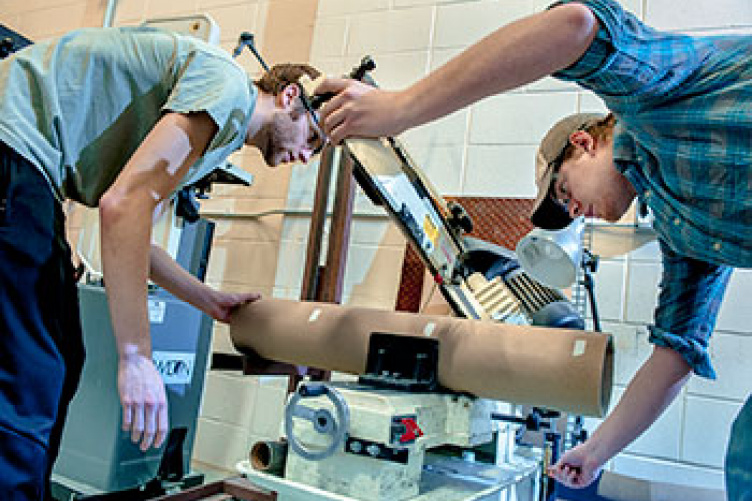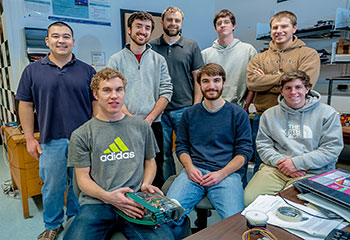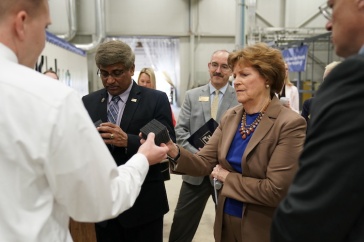
L to r, Christopher Barr and Tyler Fausnacht cut an acrylic tube for the UNH-ROV.
Spring is just around the corner for two of this year’s Parents Association awardees. The teams, UNH-ROV and ET SwarmCats, are in the throes of constructing robots in time for the Undergraduate Research Conference to be held in April. One group’s robot will explore underwater and the other is aiming for space, but in any case, it’s a tight schedule.
The robots, or “bots” as students call them, seem to have their own educational mission since constructing them demands high-intensity interdisciplinary collaboration. Since day one at UNH, these students have been knocking out team projects in their own disciplines. But now mechanical engineering, computer science, and electrical and computer engineering students find themselves rubbing elbows.
The UNH Remotely Operated Vehicle (ROV) team plan to enter their robot, the ROV, at the International Marine Advanced Technology Education (MATE) ROV Competition in Michigan this June and, just to keep the pressure up, they will present at the Undergraduate Research Conference. For fun, they’re even putting on a “ROV Day” at UNH for local high school students. The team’s ROV will also double as an experimental platform for graduate-level research in the control of multiple Unmanned Underwater Vehicles (UUVs). Funding from the Parents Association has helped the team to buy materials.
But first they must design and build a ROV capable of maneuvering a submerged mock shipwreck with an arm that can retrieve objects. On a Monday night in the Jere Chase Ocean Engineering building next to the wave/tow tank, the team lines up at their different stations and begins their regular weekly meeting. And, they have a lot of work to do.
The good news is that UNH has had an ROV team for several years and, as team co-captain Tyler Fausnacht notes, “We’ve got the old ROVs to study and grab parts from. The 2011 ROV was really good. But the big leap forward was in 2008 when the ROV went from analog to digital—huge.”
|
This rendering of the Remotely Operated Vehicle (ROV) shows the two clear acrylic tubes, which house the electronics; the black thrusters, which provide propulsion; and the chassis, which holds everything together. |
Right now, Fausnacht and his chassis group are making the clear acrylic tubes that will be waterproofed to house the electronics. He says, “It’s challenging because the tubes aren’t perfectly round. When we get a cap fabricated, it really has to fit.”
One team member lists the epoxies, grease, and testing protocols that they’ll use on the tubes and notes: “Waterproofing is the hardest part.”
Meanwhile, two computer science students focus intently on a Playstation controller that’s hooked up to a laptop, a board of computer chips, and a black thruster from their propulsion system. The two of them code and test, over and over, while the thruster whirls and shuts off, again and again. Meanwhile, the electrical and computer engineering team member twists up a colorful mix of wires to power up and connect yet another thruster to prepare for testing. The three of them began working on all of this last fall.
Nick Geist, the other co-captain, chuckles and says, “The controls group is semi-autonomous.”
However, when it comes to the competition, there’s no question among the team as to who will pilot their ROV for accuracy and speed. Geist says simply, “It will be one of the computer science guys. You want someone who really knows the code to pilot.”
Meanwhile Fausnacht notes, “By April, it’s got to be moving around underwater.”
Meanwhile, the ET SwarmCats, aka the Extra-Terrestrial Navigation with Particle Swarm Optimization team, have convened in the Advanced Control Lab, their home base in Kingsbury Hall. Upon arrival, the group disperses to their work areas and the ET SwarmCat takes center stage.
About the size of a lunchbox, this robot is a clear plastic box that houses a bunch of wires with a green caterpillar track attached on one side. Clearly, beauty is in the eye of the beholder. Team captain Stephen Swanick quickly explains that it is still in process. Once it’s completed the ET SwarmCat will be able to crawl about on all sorts of terrain.
In fact, the hope is that the ET SwarmCat may one day help create the technology to be able to explore other planets or asteroids in search of precious natural resources. And it wouldn’t be just one. Rather it would be a lot of ET SwarmCats working independently using their sensors to communicate with one another to make decisions and reach a common goal. As the team explains in their proposal: “Throughout nature swarms can be found in every facet of life, even down to the molecular level and bacteria. It makes sense to harness particle swarm optimization for use in space.”
|
Front, l to r, Erik Larson, Daniel Bolan, Joseph Jourdain, back, l to r, Tim Mitsopoule, Mike Johnson, Jesse Davis, Brett Ruggles, Stephen Swanick |
Mike Johnson, the team’s graduate student adviser, has implemented a key algorithm and written the code to program the ET SwarmCats. He holds a thick notebook, filled with neat, penciled calculations. “We’re working to have the robots find the highest elevation point in a given area. But for example, we could’ve programmed the sensors to look for the brightest spot,” says Johnson, adding slowly, “What we’re looking for is ‘proof of concept.’”
If this robot swarm works, it might be a breakthrough. Something NASA might be interested in developing. It’s a race. The technology of particle swarm optimization is being studied all across the world.
While the team perfects its first ET SwarmCat, more are planned.
“We plan to make 15 by April,” says Swanick.
Another student pipes up, “We want the odd number to test how they might handle a split decision.”
Everyone on the team works almost simultaneously. The mechanical engineering students build the structure. The computer science students code the robot’s “brains.” And the electrical and computer engineering students wire the connections and make sure that the robot has enough power.
When asked why he wanted to be on this team, Swanick answers, “I’ve always been fascinated by space and the mechanics of how to explore it.” Clearly, the ET SwarmCats team has found a new frontier.
-
Written By:
Staff writer | Communications and Public Affairs



















































